Phonology
These are sounds for the Kashmiri language.
Click on the sounds to reveal locations in this document where they are mentioned.
Vowel sounds
Plain vowels
Diphthongs
Consonant sounds
Kashmiri has no voiced aspirated sounds.
Updated 23 October, 2025
This page brings together basic information about the Sharada script and its use for the Sanskrit and Kashmiri languages. It aims to provide a brief, descriptive summary of the modern, printed orthography and typographic features, and to advise how to write Sanskrit/Kashmiri using Unicode.
Richard Ishida, Sharada Orthography Notes, 23-Oct-2025, https://r12a.github.io/scripts/shrd/ks
𑆄𑆯𑇀𑆖𑆫𑇀𑆪𑆁 𑆯𑆶𑆢𑇀𑆣𑆱𑆠𑇀𑆠𑇀𑆮𑆱𑇀𑆪 𑆬𑆾𑆑𑆼 𑆬𑆾𑆑𑆳𑆤𑆶𑆮𑆫𑇀𑆠𑆴𑆤𑆾𑇅 𑆯𑆴𑆑𑇀𑆰𑆴𑆠𑆂 𑆱𑆫𑇀𑆮𑆯𑆳𑆱𑇀𑆠𑇀𑆫𑆼𑆰𑆶 𑆬𑆴𑆥𑆴𑆯𑆳𑆬𑆳𑆩𑆶𑆥𑆳𑆓𑆠𑆂𑇅 𑆪𑆼𑆰𑆳𑆩𑆲𑆁 𑆤𑆳𑆩𑆣𑆼𑆪𑆁 𑆬𑆴𑆥𑆵𑆤𑆳𑆁 𑆤 𑆥𑇀𑆫𑆘𑆳𑆤𑆩𑆴𑇅 𑆠𑆠𑇀𑆫𑆽𑆰 𑆯𑆴𑆑𑇀𑆰𑆴𑆠𑆂 𑆱𑆤𑇀𑆠𑆾 𑆬𑆴𑆥𑆴𑆯𑆳𑆬𑆳𑆩𑆶𑆥𑆳𑆓𑆠𑆂𑇅
Source: Vinodh Rajan
Sharada ( 𑆯𑆳𑆫𑆢𑆳 ) is a South Asian abugida used in India for Sanskrit and Kashmiri. After widespread use in Kashmir and neighbouring areas, it later became restricted to Kashmir, and is now rarely used, except by the Kashmiri Pandit community for religious purposes (although there is some interest in reviving it).
Sharada was used as the principal script in Kashmir from the 8th to 20th century for Sanskrit, Kashmiri, and other languages. The script's use in inscriptions began to decline in the 19th century due to the rise of Persian and Devanagari scripts.
The name "Sharada" comes from a Sanskrit name for Kashmir or the goddess of knowledge, Sarasvatī. The name is relatively recent and also appears in various English forms.
Geographically, Sharada's core region is between longitudes 72°-78° east and latitudes 32°-36° north, with inscriptions found from Afghanistan to Uttar Pradesh.
Sharada evolved from Gupta Brahmi through the Kutila script in three stages: 8th-9th centuries, 9th-10th centuries, and 11th-13th centuries, with inscriptions and manuscripts as evidence. By the 15th century, it evolved into scripts like Takri, Landa, and Gurmukhi. Sharada's decline continued into the 19th century, with limited modern use among Kashmiri Pandits for rituals and horoscopes.
Interest in Sharada persists in the scholarly community, with efforts to preserve and study the script in India and Germany.
Unicode 17 has 2 dedicated Sharada blocks, comprising 104 characters.
More information:
Sharada is an abugida. Consonant letters have an inherent vowel sound. Combining vowel signs are attached to the consonant to indicate that a different vowel follows the consonant. See the table in the right-hand column for a brief overview of features for the Sharada orthography.
Sharada text runs left-to-right in horizontal lines.
The basic consonant sounds of Sanskrit and Kashmiri are represented using consonant letters. Kashmiri uses 3 additional letters formed by combining with the nukta diacritic. Kashmiri also commonly indicates palatalisation of consonants, using 𑆪𑇀.
An unusual feature is that 2 letters used to represent allophones of h in consonant clusters have to be rendered above the following consonant.
Syllable-final nasals can be represented by 11181. Sanskrit also uses 11182.
Given that consonants normally include an inherent vowel, the orthography needs a way to indicate when a consonant is not followed by a vowel.
Consonant clusters (and palatalisation) are indicated using the virama between consonants. The virama is often visible and appears alongside the preceding consonant letter, however in several cases the cluster may also be rendered as a conjunct. Conjunct forms are normally stacked. There are no dedicated medial consonants. Word-final codas are written using ordinary letters or the anusvara/visarga combining marks.
❯ basicV
Sharada has one inherent vowel, pronounced a. Post-consonant vowels are represented using vowel signs. All post-consonant vowel signs are combining marks. There are no multipart vowels and no circumgraphs. There is 1 pre-base vowel sign.
All Sanskrit standalone vowel sounds are written using independent vowel letters. Kashmiri, however, has additional standalone vowels that are represented using other vowel signs attached to one of 3 independent vowels used as a base.
Two vowel signs and letters represent diphthongs.
Sharada has a set of 4 vocalic letters, both vowel signs and independent vowel letters.
Vowels may be nasalised, using the diacritic 𑆀, or sometimes 𑇏.
Native digits are used. Punctuation is mostly native, though some ASCII punctuation is used. There are also section end markers and head marks.
tbd
These are sounds for the Kashmiri language.
Click on the sounds to reveal locations in this document where they are mentioned.
Kashmiri has no voiced aspirated sounds.
This table summarises only basic vowel to character assignments. Click on the phonetic transcriptions for more detail.
ⓘ represents the inherent vowel. Diacritics are added to the vowels to indicate nasalisation (not shown here).
| post-consonant | standalone | |
|---|---|---|
| Plain: | ||
| Diphthongs: | ||
| Vocalics: |
For additional details see vowel_mappings.
𑆑 ka
The inherent vowel for Sharada consonants is a, and ka is written by simply using the consonant letter, eg.
𑆑𑆩𑆬
| 𑆑,𑆩,𑆬 |
Since Sharada consonants normally include an inherent vowel, the orthography has ways to indicate a consonant that is not followed by a vowel sound. See novowel.
Vowels after consonants are written using using vowel signs. All vowel signs are combining marks. There are no multipart vowels and no circumgraphs. There is 1 pre-base vowel sign.
All vowel signs are typed and stored after the base consonant, and the rendering process puts them in the correct place for display.
Three vowel signs are spacing combining characters, meaning that they consume horizontal space when added to a base consonant.
𑆑𑆵 kiː
For simple Sanskrit post-consonant vowels, Sharada uses the following dedicated combining marks.
The Kashmiri language contains a number of additional sounds that do not appear in Sanskrit. Representation of those sounds has varied in the past, but recently agreement was reached to use an additional set of vowel signs to cover them. Those vowel signs are not yet encoded in Unicode (due in version 17), and are not available in the font used for this page, but the list will be as follows. The actual shapes are shown in fig_kashmiri_vowel_signs.

Previously, other diacritics were used to help write the vowel sounds that occur in Kashmiri but not in Sanskrit. Pandey found no evidence of their use after the beginning of the 20th century. These diacritics include 𑇋 and 𑇌. For more information about them, click on their names or see Pandeypk.
𑆑𑆽 kaːi̯
Single vowel signs are also used to write 2 diphthongs.
𑇎 was used in early and medieval documents in concert with other vowel signs to write the 4 vowels e, ai, o, and au. It's use declined in the 15th century.pp
Similarly to some other Indic scripts, such as Tamil, the vowel signs 𑆶 ʊ, and 𑆷 uː, tend to create special ligated forms with the consonant letter they follow.
See the examples just below. The first item in the list shows the default shape for reference, where the vowel sign does not create a ligature, but behaves like other vowel signs.
A few other vowel signs exhibit similar behaviour. See the list below. (Hint: to see the original shapes of the consonants, click on the ligature.)
𑆑𑆴 ki
The vowel sign 𑆴 appears to the left of the base consonant letter or cluster.
This is a combining mark that is always typed and stored after the base consonant(s), ie. the codepoints follow the order in which the items are pronounced. The rendering process places the glyph before the base consonant without changing the code points.
The following example shows how the initial vowel sound is stored after the consonant, even though it is displayed to its left.
𑆢𑆳𑆝𑆴𑆩
| 𑆢,𑆳,𑆝,𑆴,𑆩 |
Vowel length is indicated by the vowel sign used (see plainV and kashmiriV).
Nasalisation of the vowel in a syllable is generally indicated using 11180 above the vowel. An alternative shape, 111CF can also be found, and sometimes in the same manuscript. For more information see Pandey.
Sanskrit standalone vowels are written using a set of independent vowel letters. The set contains a character to represent the inherent vowel sound, and 2 letters representing diphthongs.
However, the additional vowel sounds in Kashmiri are represented by 3 of the above letters combined with a vowel sign listed in kashmiriV. The following list contains the standalone vowel representations for the additional Kashmiri vowels. Rajan lists alternative base letters for ɔ and ɔː.
fig_kashmiri_vowel_signs shows the actual shapes.

This section maps Kashmiri or Sanskrit vowel sounds to common graphemes in the Sharada orthography.
vowel sign 𑆴
standalone 𑆅
vowel sign 𑆵
standalone 𑆆
vowel sign Used for extra vowels for Kashmiri.
standalone 𑆃 Used for extra vowels for Kashmiri.
vowel sign Used for extra vowels for Kashmiri.
standalone 𑆃 Used for extra vowels for Kashmiri.
vowel sign 𑆶
standalone 𑆇
vowel sign 𑆷
standalone 𑆈
vowel sign Used for extra vowels for Kashmiri.
standalone 𑆍 Used for extra vowels for Kashmiri.
vowel sign 𑆼
standalone 𑆍
vowel sign Used for extra vowels for Kashmiri.
standalone 𑆏 Used for extra vowels for Kashmiri.
vowel sign 𑆾
standalone 𑆏
vowel sign Used for extra vowels for Kashmiri.
standalone 𑆃 Used for extra vowels for Kashmiri.
vowel sign Used for extra vowels for Kashmiri.
standalone 𑆃 Used for extra vowels for Kashmiri.
vowel sign Used for extra vowels for Kashmiri.
standalone 𑆃 Used for extra vowels for Kashmiri.
vowel sign Used for extra vowels for Kashmiri.
standalone 𑆃 Used for extra vowels for Kashmiri.
inherent vowel eg. 𑆑𑆤𑇀
standalone 𑆃
vowel sign 𑆳
standalone 𑆄
vowel sign 𑆽
standalone 𑆎
vowel sign 𑆿
standalone 𑆐
𑆀
𑇏 Alternative shape.
Sharada has 4 vocalic vowel signs and 4 corresponding independent vowels.
Follow these links for more information.
Sharada uses 𑇀 to indicate that there is no inherent vowel after a consonant.
The virama is often visible in Sharada text. It is unusual in that it appears to the right of the consonant whose vowel it cancels, much like a letter.
𑆃𑆧𑆾𑆢𑇀
𑆑𑆳𑆯𑆶𑆫𑇀
When it appears, it is often after a word-final coda. However, out of 47 terms currently in the term list that end with a consonant sound, 29 have no virama at the end, while 18 do.
A visible virama also occurs in the sequence 𑇀𑆪𑇀 at the end of a word, which is used to represent palatalisation.
To produce a conjunct, 𑇀 is added between the consonants in a cluster. When a conjunct is formed, the virama itself is not displayed. For example:
| 𑆩,𑇀,𑆧,𑆩𑇀𑆧 |
Sharada fonts normally stack the component consonant letters, using reduced glyphs for the non-initial consonants.
| 𑆑,𑇀,𑆱,𑆑𑇀𑆱 |
| 𑆠,𑇀,𑆫,𑆠𑇀𑆫 |
| 𑆒,𑇀,𑆪,𑆒𑇀𑆪 |
Whether the virama is visible or not in consonant clusters depends on the font used. Only a small number of clusters are rendered as conjuncts in the Noto Sharada font, whereas the Satisar Sharada font appears to represent all clusters as conjuncts.
The Noto Sans Sharade font commonly uses a visible 𑇀 between consonant letters to indicate the absence of the inherent vowel. The Noto Sans Sharada font currently shows only the following combinations of CvC as stacked. The other combinations have a visible virama.
Conjuncts can include a sequence of 3 consonants, each separated by a virama. The sample text at the top of the page has a conjunct with 3 consonants.
𑆯𑆶𑆢𑇀𑆣𑆱𑆠𑇀𑆠𑇀𑆮𑆱𑇀
See a table of 2-consonant clusters.
The table allows you to test results for various fonts.
Pandey's proposal documentp,41-42 contain a list of many more conjuncts on pages 41–42, including a number of 3 consonant conjuncts.
Sharada uses 2 characters to indicate sandhi. 𑇁 represents the elision of word-initial a, and is a spacing letter written on the baseline, but (unlike Devanagari) not joining the headstroke. 𑇉 is a combining character, written in some manuscripts below the syllable following the location of external sandhi. In some cases, it may be written twice to indicate sandhi between 2 long vowels. For examples, see Pandeypsan.
This table summarises only basic consonant to character assignments. Click on the phonetic transcriptions for more detail.
|
|
|
|
|
|
For additional details see vowel_mappings.
The following is a list of basic Sharada consonants. All of these are used for Sanskrit, but not all are used for native Kashmiri words.
Click on each letter for more details and for examples of usage.
The list of sounds used for native Kashmiri words doesn't include voiced aspirated consonants and a few others. The following is likely to be a basic set for Kashmiri.
The additional consonant sounds needed for Kashmiri can be written using one of the above characters with 𑇊. These include:
None of these combinations exist in atomic form.
Palatalisation is a frequent feature of Kashmiri words. It is represented using 𑆪 as the final element of a consonant cluster.
Inside a word the YA forms a conjunct or a cluster with the preceding consonant.
𑆒𑇀𑆪𑆩𑆳
At the end of a word, the YA is followed by a visible virama.
𑆄𑆯𑆤𑇀𑆪𑇀
Since they are palatal sounds, the YA is not needed after the following consonants.
Two letters representing allophonic variants of h in consonant clusters require special handling. In both cases, the letter is rendered above the following consonant letter. Although the standalone rendering of these characters looks like a combining mark, both actually have a General Category value of letter.
𑇂 represents the sound x before k or kʰ.
𑇃 represents the sound ɸ before p or pʰ.
Grapheme clusters do not separate the 2 letters in these sequences.
Observation: The placement of certain vowel signs in the Noto Sans Sharada font marks these combinations out as different from normal conjuncts, since the jihvamuliya is sometimes separated above the vowel-sign for the first two examples in the list above. Similar placement occurs for upadhmaniya, too.
Clusters of consonant letters at the beginning of an orthographic syllable are handled as described in the section clusters.
𑆒𑇀𑆪𑆩𑆳
𑆥𑇀𑆫𑆠
Sharada appears not to use a special rendering for medial r.
Wiktionary data shows some words that end with a consonant letter and a following virama (link), but other words that end without the virama (link).
Sharada also has 2 dedicated characters for syllable codas.
11181 represents a nasal that is homorganic with a following consonant. It is positioned over the previous consonant or vowel sign.
𑆒𑆁𑆖𑇊
𑆃𑆁𑆘𑇊
Observation: When using the Devanagari script, the visarga is not used in Kashmiri. That may also be the case for Sharada. Research needed.
Gemination and consonant lengthening are handled using the normal approach to consonant clusters (see clusters).
This section maps Kashmiri/Sanskrit consonant sounds to common graphemes in the Sharada orthography.
Sounds listed as 'infrequent' are allophones, or sounds used for foreign words, etc. Light coloured characters occur infrequently.
𑆥
𑆦
𑆧
𑆨 Not used for native Kashmiri.
𑆠
𑆡
𑆖𑇊 For Kashmiri.
𑆖
𑆗
𑆢
𑆣 Not used for native Kashmiri.
𑆘
𑆙 Not used for native Kashmiri.
𑆛
𑆜
𑆝
𑆞 Not used for native Kashmiri.
𑆑
𑆒
𑆓
𑆔 Not used for native Kashmiri.
𑇃 An allophone of h. Only found in the combinations ɸp or ɸpʰ.
𑆱
𑆯
𑆰 Not used for native Kashmiri.
𑆘𑇊 For Kashmiri.
𑇂 An allophone of h. Only found in the combinations xk or xkʰ.
𑆲
𑆩
𑆁 Coda.
𑆤
𑆁 Coda.
𑆚
𑆟 Not used for native Kashmiri.
𑆕
𑆮
𑆫
𑆫
𑆬
𑆭
𑆪
vowel sign 𑆸
standalone 𑆉
vowel sign 𑆹
standalone 𑆊
vowel sign 𑆺
standalone 𑆋
vowel sign 𑆻
standalone 𑆌
The Sharada Unicode block contains an atomic character to represent OM, 𑇄, but recommends that a decomposed sequence be used, instead, ie. 𑆏𑆀. The atomic character and the sequence are not canonically equivalent.
It is also possible to find the sequence 𑆏𑇏 as a spelling for OM.
This section offers advice about characters or character sequences to avoid, and what to use instead. It takes into account the relevance of Unicode Normalisation Form D (NFD) and Unicode Normalisation Form C (NFC)..
Although usage is recommended here, content authors may well be unaware of such recommendations. Therefore, applications should look out for the non-recommended approach and treat it the same as the recommended approach wherever possible.
This table lists characters that are often mistakenly used because they look the same as or similar to other code points that should be used, or perhaps because the correct character is not available on the user's keyboard.
| Correct | Incorrect | Notes |
|---|---|---|
| 𑆏𑆀 | 𑇄 | Not canonically equivalent. Atomic character deprecated by the Unicode Standard. |
The following atomic characters look as if they could be composed of parts, but in fact there is no equivalence during normalisation, and so the atomic characters only should be used.
| Atomic | Sequence ( DO NOT use! ) |
|---|---|
| 𑆎 | 𑆍𑆼 |
Combining marks always follow the based character.
Sharada has a set of native digits, as follows:
Text in the Sharada script runs left to right in horizontal lines.
Show default bidi_class properties for characters in the Kashmiri orthography described here.
You can experiment with examples using the Kashmiri character app.
Most consonants have a headstroke. In some cases all headstrokes in a word join (like in Devanagari), but Pandey describes other approaches where Sharada consonant headstrokes may join only with dependent vowel signs, or may join in an arbitrary fashion.p,18 The examples just below (using the Noto Sans Sharada font) are of the second type. The gaps probably make it easier to read text such as in the first example below, because Sharada has a number of vertical lines that could be confused.
𑆯𑇀𑆮𑆒𑆶𑆫
𑆑𑆳𑆯𑆶𑆫𑇀
Alignment of the top bar may be appropriate when mixing text of different sizes (see initials). Also, when Sharada text is mixed with another script that also has a top bar, such as Devanagari, the top bars of both scripts may need to be aligned.
𑇜 is a headstroke continuation mark that is used to join letters across imperfections in the writing surface, such as are found in birch-bark manuscripts.ph It does not appear to be used for indicating gaps and omissions.
Context-sensitive shaping is required in a number of cases for Sharada. Examples include the following:
The vowel signs 𑆶 and 𑆷 have special, ligated forms when used with certain consonants. See uLigatures.
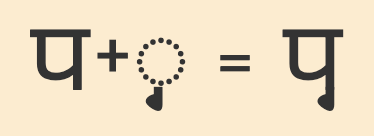
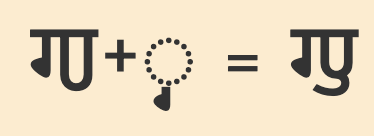
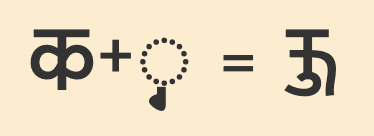


Combining characters need to be placed in different positions, according to the context. Examples include the following.
The placement of a diacritic, such as 𑆶, depends on the shape of the base letter to which it is attached.
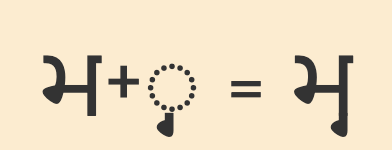
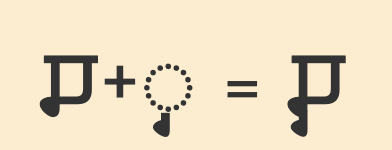
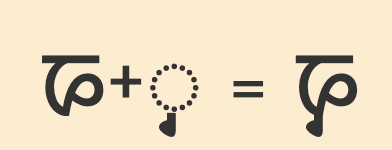
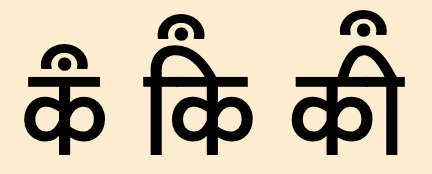
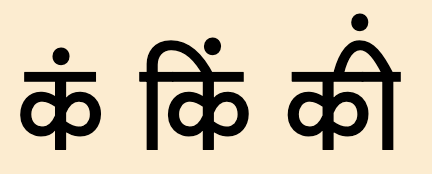
In modern Sharada texts word boundaries are indicated by spaces. However, in some manuscripts a punctuation mark was used instead, though not always consistently, to mark word boundaries. For this, Unicode provides the 𑇈. Pandey provides an example of usage.p,21
tbd
Sharada uses dandas, and more modern texts use some Latin punctuation.
The following punctuation characters have been seen while researching Sharada text for this page. There are likely to be more.
| phrase | , |
|---|---|
| sentence | 𑇅 ? |
| paragraph | 𑇆 |
| section |
𑇞 𑇟 𑇍 |
𑇞 and 𑇟 are used to indicate the end of a section of text. For examples of usage see Pandey.
𑇍 is a sutra end mark, used in ancient manuscripts, especially the Bakhshali Manuscript (2nd-4th centuries CE) to indicate the end of a sutra, or 'rule'.psut
𑇛 is an opening head mark. The shape may vary. Pandey describes this as used in Sharada records. It represents Sanskrit salutory phrases, such as oṃ ‘Om!’, siddham ‘established!’, and svasti ‘hail!’. It appears frequently in Sharada inscriptions.
.psid
𑇚 is an invocation sign, used at the beginning of texts to represent the Sanskrit word 𑆍𑆑𑆁 eːkɐm one. It is also used in salutory phrases such as oṃ svasti ekaṃ siddhaṃ, meaning Om hail! One established..pe
The following characters have been noted during research into Sharada texts for this page. More characters may be relevant here.
| start | end | |
|---|---|---|
| initial |
« |
» |
𑇇 in the Sharada Unicode block is commonly used for abbreviationsp,21.
𑆮𑆴𑇇𑆱𑇇 𑇑𑇐
Modern Sharada is normally wrapped at word boundaries.
Reproduction of archaic manuscripts which do not have spaces between words will need to break after 𑇈 or 𑇝.
Authors may use 𑇝 where a word is broken at the end of a line, but it is neither automatic nor consistent; it is only used if the author wishes to mark a particular break.pcon